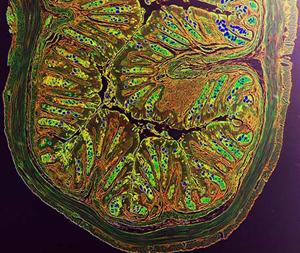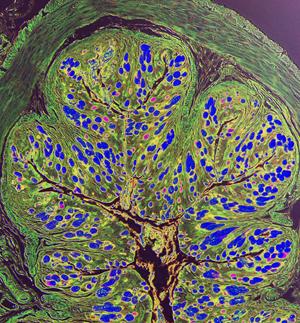
Color-enhanced histologic image showing intestinal tissue damage in a murine model of intestinal inflammation. Image courtesy of Drs. Laurel Monticelli and David Artis.
Dr. David Artis, a world renowned expert in immunology and inflammatory bowel disease research and Director of the Jill Roberts Institute for Research in Inflammatory Bowel Disease, has published a landmark paper in PNAS that provides new insight on how the intestines repair themselves after daily attacks from microbes and environmental triggers. The researchers have uncovered a self-repair mechanism that could lead to innovative approaches for the treatment of IBD (inflammatory bowel diseases) and other intestinal disorders.
Published on August 4, 2015, the article in PNAS reveals findings on a mechanism that allows the single layer of cells that line the inside of the intestines (termed the gut epithelium) to signal the immune system to repair tissue damage. A defect in this repair system underlies Crohn's disease and ulcerative colitis. By restoring the tissue-protective repair mechanisms, hallmarks of the disease could be reduced such as chronic inflammation and persistent tissue damage. Dr. Artis and his team have found one way in which epithelial cells trigger the immune system to promote repair of the barrier that protects intestinal tissue from assaults which the intestines are constantly exposed to, including food particles, microbes, pollutants, or things that might be swallowed. Research in the Artis laboratory, led by first author on the paper, Dr. Laurel Monticelli (a postdoctoral associate in the Weill Department of Medicine), found that a component of the body's immune system, ILC2 (group 2 innate lymphoid cells), plays a key role in orchestrating restoration of the intestinal barrier.

Color-enhanced histologic visualization of colonic tissue damage in a murine model of intestinal inflammation. Blue color represents mucus staining. Image courtesy of Drs. Laurel Monticelli and David Artis.
As Dr. Artis explains, when the gut lining is damaged during disease, epithelial cells produce and release a molecule called interleukin 33 (IL-33). The molecule belongs to a family known as the "alarmins" because they act as a chemical alarm system that activates neighboring cells at the site of the injured tissue. Group 2 innate lymphoid cells (ILC2) are uniquely suited to act as first responders to this alarm, rapidly producing a growth factor called amphiregulin. High levels of amphiregulin can aid in rebuilding the intestinal barrier by stimulating growth of new epithelial cells and creating a protective layer of mucus that repels future attacks.
"A very sophisticated dialogue is occurring between the gut epithelium and the innate lymphoid cell population, so tapping into that exchange may be key to maintaining gut health in humans," explains Dr. Artis.
This study was supported by the National Institutes of Health, the Crohn's and Colitis Foundation, and the Burroughs Wellcome Fund.

